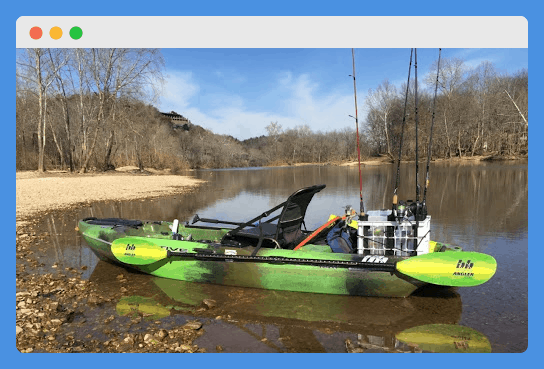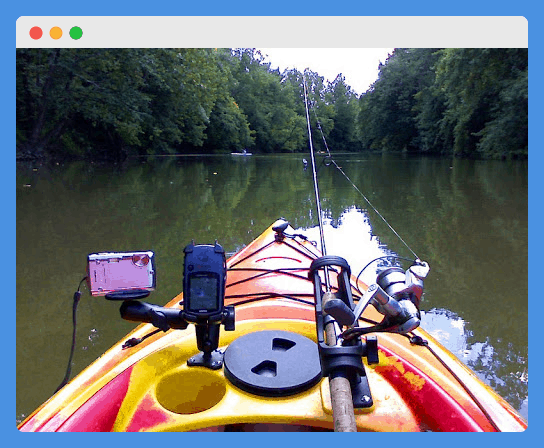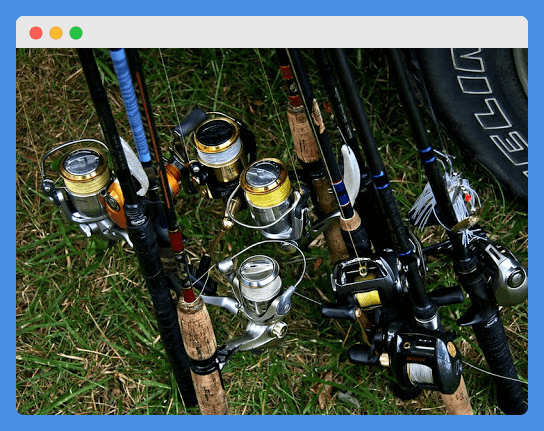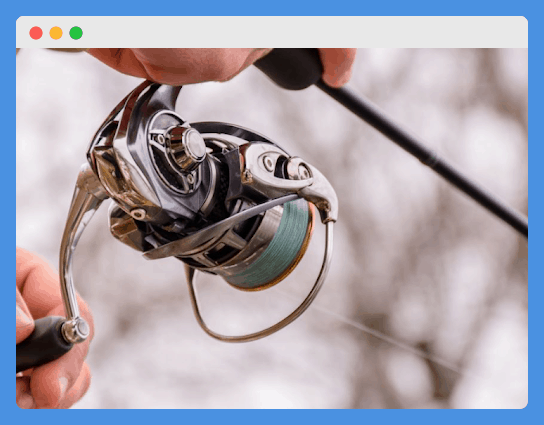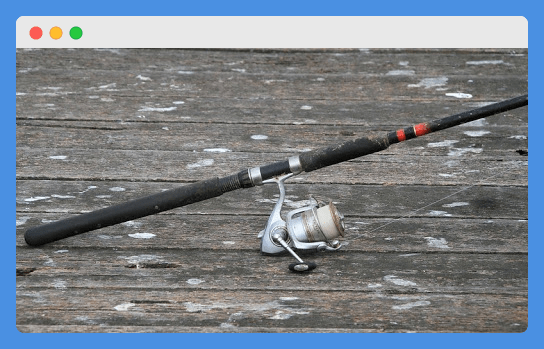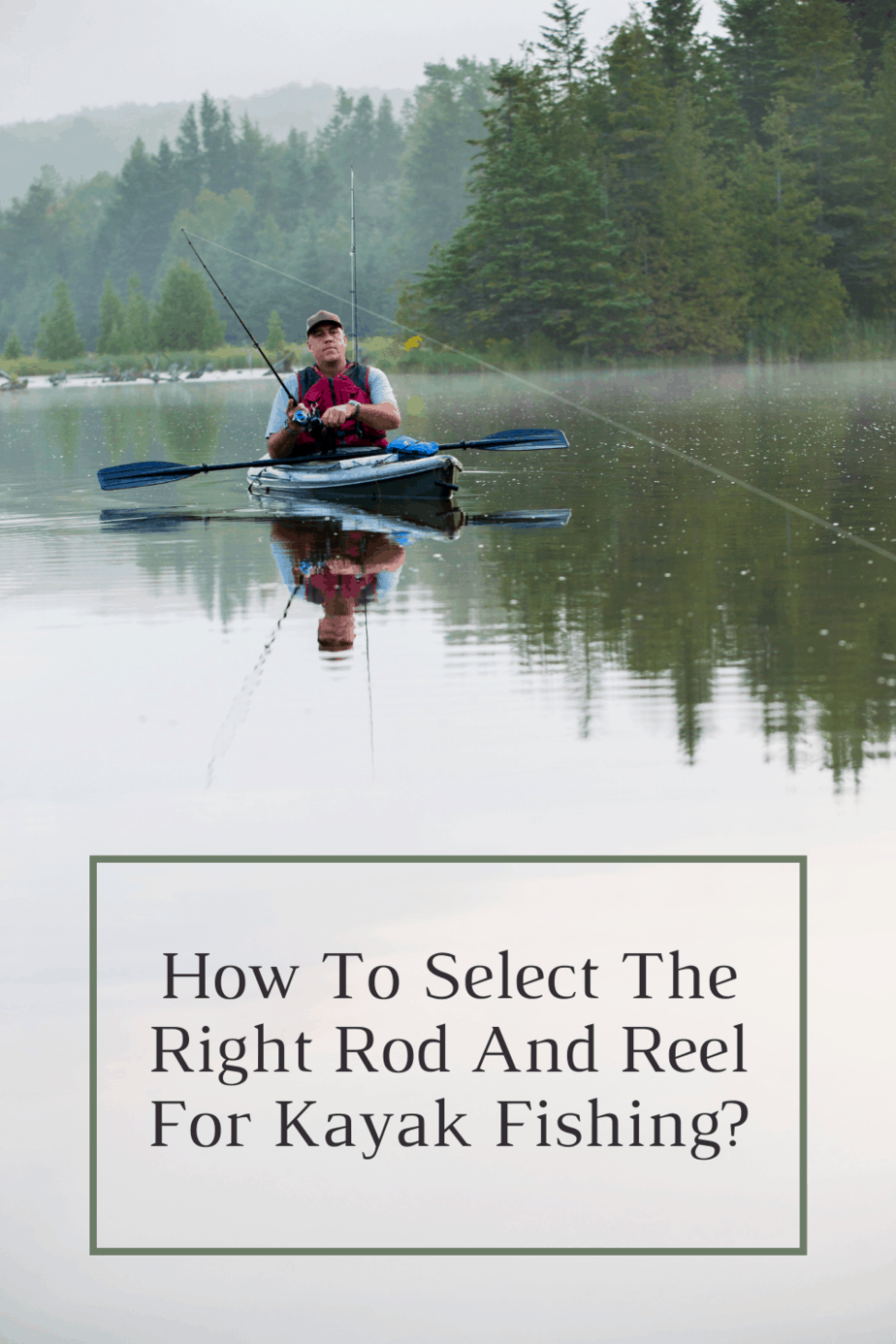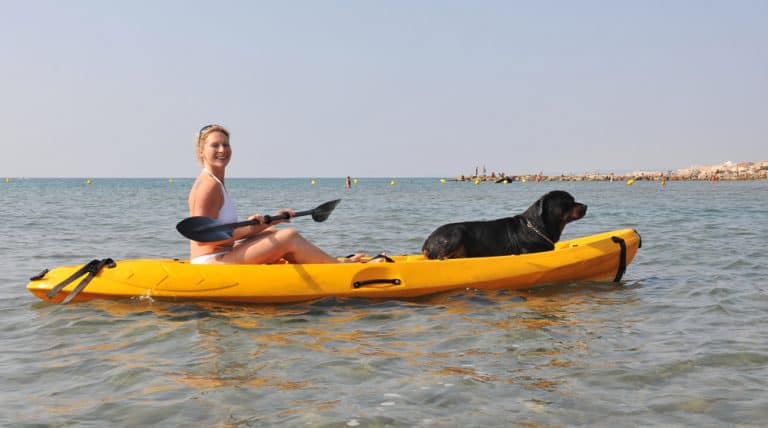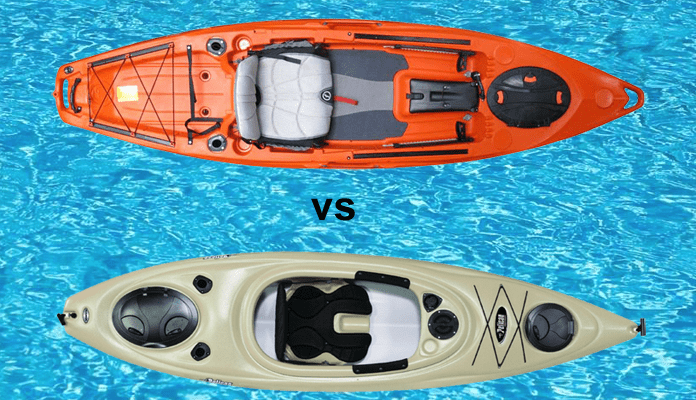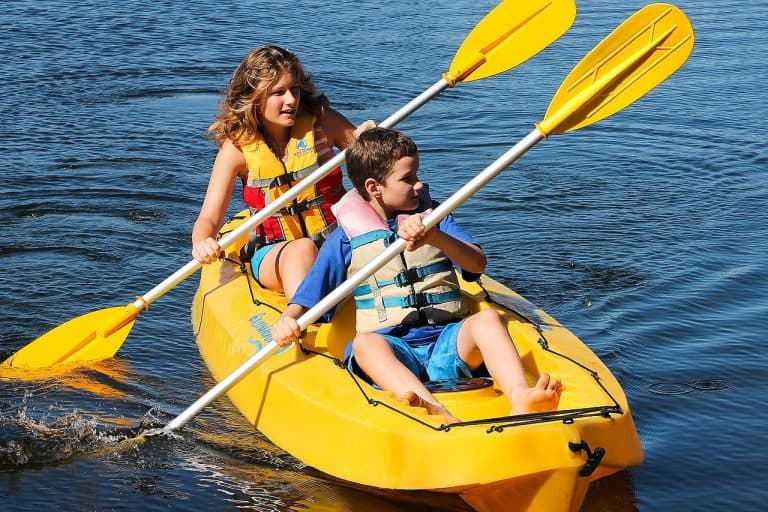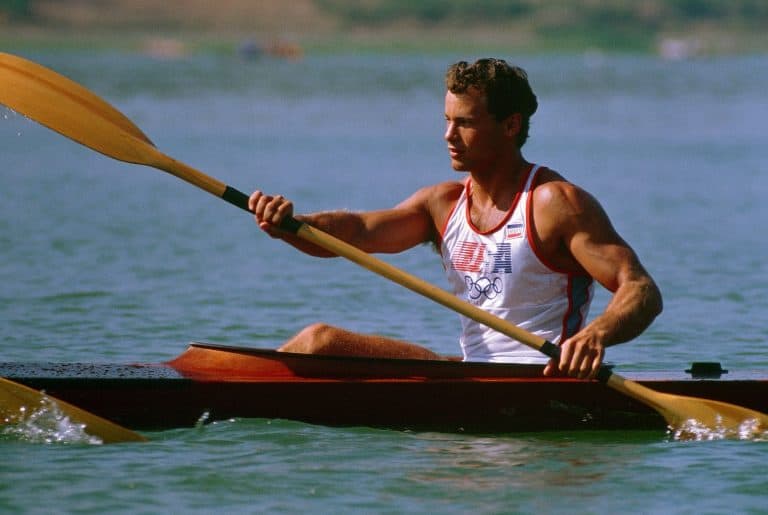Fishing from a kayak allows you to reach spots that would otherwise be inaccessible.
Fishing from land has its limitations and it’s much easier to get hooked or snagged on submerged obstacles or nearby trees.
As your options for fishing locations expand, you’ll also need to update your rod and reel setup.
Depending on where you’re fishing, you might also require multiple setups so that you can adapt to changing conditions.
Once you give it a try, you’ll find numerous advantages of kayak fishing.
In the rest of this article, we’ll offer several important advantages of kayak fishing, some tips for kayak fishing, and criteria you can use when determining how to select the right rod and reel for kayak fishing.
The Advantages Of Kayak Fishing
Accessibility
The first major advantage of kayak fishing is the ability to reach fishing holes that aren’t accessible on foot.
Kayaks can also fit into hard-to-reach locations that would be unsafe for a powerboat.
Kayaks are also far more stealthy than a powerboat. Not only will you be able to access more locations, but the fish won’t even know you’re there until it’s too late.
Economics
Kayaks are a much more affordable means of getting around your favorite waterways.
There’s a clear price difference between a fishing kayak and a powerboat, not to mention the cost of a trailer, gas, and maintenance required to keep a powerboat going.
While a great fishing kayak can be more costly than a standard sit-on-top kayak, the investment is still minimal compared to a powerboat.
Fishing kayaks also require very little maintenance and they’re much easier to store when you’re not using them.
Adaptability
Fishing kayaks can be used on a variety of waterways. Whether you like to fish saltwater bays, small creeks, or large inland lakes, a fishing kayak can adapt seamlessly to your needs.
Powerboats can require a lot of work and logistics if you like to travel between waterways.
Depending on local regulations, you might need to completely flush and clean the bilge and tanks of a powerboat before you can enter a new waterway.
With our focus on aquatic invasive species, kayak fishing is only growing in popularity.
The time you spend making sure you aren’t transporting new critters from waterway to waterway is valuable time that you could be fishing.
Relaxation
It’s hard to beat the relaxation that comes with sitting in a kayak on a warm, still day.
Kayak fishing gives you the ability to quietly enjoy the scenery of your favorite fishing holes while you work on bringing home fresh fish for dinner.
Many fishing kayaks also give you the ability to troll a line behind them.
This is a great way to keep fishing while you paddle, get a little upper body workout, and take in your natural surroundings.
Kayak Fishing Rod Buyer’s Guide
Kayak fishing does differ from shoreline fishing or fishing from a powerboat. In this section, we’ll discuss the most important criteria to consider when selecting a fishing rod for kayak fishing.
Saltwater Versus Freshwater
Kayak fishing rods can be broken down into two main types. There are rods meant for saltwater fishing and those best suited for freshwater.
Saltwater can be extremely corrosive on a fishing rod.
If you use a freshwater rod in saltwater conditions, the metallic components of the rod become much more susceptible to rust and corrosion, which is why it’s always recommended to thoroughly rinse your rod after saltwater fishing.
Saltwater rods are made to withstand the corrosive salts for much longer periods.
For this reason, saltwater rods tend to be more expensive than their freshwater counterparts.
Saltwater rods are generally a bit bulkier than freshwater rods.
This is largely because they’re designed to handle the weight of the larger fish that most saltwater anglers are after.
If you know that you’ll only be fishing freshwater lakes, rivers, or streams, you’ll be able to get away with a more affordable freshwater rod.
But if you plan to fish both saltwater and freshwater, saltwater rods give you more flexibility and versatility while also being more durable in the long run.
Rod Action
Rod action is defined by the amount of curve the rod can sustain when it is under tension.
In other words, rod action is how much the rod will bend when you have a big fish pulling on the end of the line.
The amount of rod action that’s right for you depends on the species of fish you’re going for.
More specifically, it depends on the size of those fish.
When you’re going for heavier fish, you’ll want a stiffer rod.
Stiffer rods will bend less and are able to handle the heavier weight of the fish, as well as the increased force you’ll be acting on the rod as you pull the fish in.
Obviously a heftier rod is preferable if you’re after a world-record tuna.
But the downside of a stiffer rod is less sensitivity, which can make it more difficult to know exactly when to set the hook.
If you’re fishing for smaller catches, sensitivity becomes more important so that you can be sure there’s really something on the end of the line.
This is why more flexible rods are used when fishing for smaller species.
Length
Rod length is a real consideration for kayak anglers because a kayak offers significantly less storage space than a powerboat.
For this reason, many kayak anglers opt for rods that can be broken down into multiple parts until you’re ready to assemble and cast.
Rods that break down into two or three parts are easier to store on your kayak and also take up less space in your vehicle on the way to your favorite fishing hole.
They’re also relatively easy to set up when you reach the fishing hole.
Rod length can vary greatly from four feet upwards of 14 feet. Generally speaking, a longer rod will allow you to cast further and shorter rods will give you more accuracy in tight spaces.
Stability is also an important factor when fishing from a kayak.
They are obviously much narrower than a powerboat and your rod length plays into whether or not you go for an unexpected swim after hooking into that record-setting catch.
Most kayak anglers opt for rods in the six to eight-foot range.
Mid-length rods provide a healthy balance of casting distance and accuracy while also being easy to maneuver when a fish is on.
If space on your kayak is your primary concern, you should look for a shorter rod length.
Some other factors that can impact your rod length choice include the type of lure you’re using and the species of fish you’re after.
Weight
Because you’ll primarily be fishing from a seated position in a kayak, the weight of your reel becomes more important than you might think.
You won’t be able to use your lower body in your casting action, which means a heavier rod can cause fatigue more quickly.
For this reason, many kayak anglers opt for lighter rods. This makes casting much easier and also allows you to sustain energy for multiple hours instead of coming in after a handful of casts.
Graphite is the lightest material used in fishing rods.
But when you keep the length of your rod in that six to eight-foot range, you’ll find that most are reasonably light enough to keep you fishing all day long.
Materials
Most fishing rods are made of some choice of graphite, fiberglass, or composite materials and many have stainless steel guides.
Some rods also use a combination of these materials to achieve the desired effect.
These are the materials of choice because they are both highly flexible and highly durable.
You want a rod that’s going to flex adequately when a big fish is on, but you don’t want your rod to snap or splinter under that pressure.
Expert anglers tend to prefer rods made of graphite.
This is because graphite rods are lighter and more sensitive, which allows anglers to notice a bite or nibble more quickly.
But there are also downsides to graphite rods, namely when it comes to cost.
Graphite rods are more costly than rods made of other materials and they also tend to be less durable.
If a graphite rod doesn’t fit your budget or you’re a beginner or intermediate level angler, a fiberglass rod is a nice alternative.
While they aren’t as sensitive as graphite rods, fiberglass is more durable and forgiving to your learning curve.
Whether they’re primarily made of graphite or fiberglass, the guides of many fishing rods are made of stainless steel.
This component can be the most likely to rust or corrode in saltwater environments, so keeping an eye on wear and tear in this area is essential.
Mounting Capability
One of the best aspects of kayak fishing is that you can mount a rod on your kayak for hands-free fishing.
This allows you to maneuver your kayak into new locations or just sit back and enjoy some sunlight as your bait trolls behind your boat.
But not all fishing rods are made to be mounted to a kayak. You’ll need to be sure that the rod you choose is compatible with the mounting options on your kayak of choice.
Most kayaks simply have flush mounts behind the seat of the kayak.
But some will also offer rotating mounts that allow you to change the angle of your line and change your technique as you paddle.
The major consideration with mounting capability is that the butt of the rod will fit into the mounts on your kayak.
Measure the circumference of the butt of your rod and make sure that its circumference will fit in the mounts on your kayak.
You should also consider the length of the butt of your rod in this process. A rod with a shorter butt section might not be usable when placed in a kayak with very deep mounts.
When it comes to the length of your rod’s butt, just make sure that you can still use the reel adequately when the rod is mounted. Otherwise, your rod functionality will be compromised.
Security
One of the dangers of kayak fishing is your line getting snagged while you’re paddling.
If you fail to notice this as you’re paddling to a new location, your entire rod and reel can be pulled into the water and lost forever.
Keeping this danger in mind, many kayak anglers choose rods that come with a leash for added security.
Rod leashes allow you to secure the rod to a hard point on your kayak so that you can recover it if you experience the above scenario.
Some people find a leash to be inconvenient and if you only plan to have a line in the water when the rod is in your grasp, it might not be necessary.
But if you plan on trolling a line behind your kayak or doing any other sort of hands-free fishing, a leash is a must-have feature when choosing your fishing rod.
If you feel that a leash would be cumbersome but security is still important to you, there is another option.
You can also look into rod floaters to keep your rod on the surface if it does slip out of your grasp.
Kayak Fishing Reel Buyer’s Guide
Your reel choice is just as important as the type of rod. Fishing reels can be made for left or right-handed use and come with various types of action.
In this section, we’ll cover the most important criteria for choosing the right reel for kayak fishing.
Saltwater Versus Freshwater
Just like with your rod choice, you need to make sure that the reel components can withstand the environment where you fish most often.
Saltwater reels are made to withstand brackish environments and are also more adaptable to use in freshwater conditions.
The key thing to look for is “rust-resistant” components.
This includes everything from the metals used in the overall construction all the way down to the smallest ball bearings.
If you’re even slightly on the fence about trying out your rod and reel combo for kayak fishing in saltwater environments, select a reel that can withstand those conditions.
Only those that are land-locked and sure that they’ll only be fishing in freshwater shouldn’t be concerned about the effect of salt on the components of their reel.
Bearings
The bearings are largely responsible for the performance of a reel. More bearings can lead to improved performance, but the quality of each bearing also comes into play.
For starters, noise and vibration are two clear signs of poor-quality bearings.
You’ll be able to both hear and feel if a reel has substandard bearings and it will make for a long, uncomfortable day of casting.
Generally speaking, a reel that includes more bearings will offer smoother casting and easier retrieves.
More bearings also help to reduce the amount of noise and vibration you’ll hear and feel as you use it.
That being said, a reel with higher quality bearings will perform better than one with lower quality bearings, regardless of the number of bearings themselves.
This means that even just four quality bearings are better than twelve lower quality bearings.
What sets good bearings apart from great ones comes down to the materials they are made from and how they are made.
Many bearings are made from stainless steel, for example, but the addition of different alloys will make them harder and smoother, which in turn reduces noise and vibration.
The application of various alloys can also make bearings more or less resistant to rust and corrosion.
Chromium, for example, is one of the most common alloys added to stainless steel bearings to increase corrosion resistance.
When looking at the specifications of a reel’s bearings, it’s always good to look for “corrosion-resistant” or “anti-rust” bearings.
These bearings will perform better and last longer than others that don’t boast these features.
A final consideration on the note of bearings is about the grade of lubrication used in the reel.
A higher grade of lubricant will serve to both extend the life of the bearings and help the reel spin more smoothly when casting and retrieving.
Construction
When it comes to construction, there are two main factors that most reel manufacturers strive to balance. Those factors are strength and weight.
A lighter reel makes it easier to cast all day without getting fatigued. But the reel also needs to be strong enough to withstand that catch that’s just above its maximum test.
It’s hard to pre-select for the exact size of the fish that decides to bite, so a quality reel needs to handle the torque that a big fish will produce.
The most durable reels on the market today utilize all-metal components.
Reels with all-metal components also tend to be reasonably priced.
Reels that fall into the higher price range are those that utilize more sophisticated alloys that offer lightweight performance while striving not to compromise on strength.
When looking at the construction of various reels, it’s important to also note the species and size of fish you’ll be going for. This will dictate just how strong your reel needs to be.
If you’re going after small to medium-sized fish, you’ll probably get away with a reel constructed of graphite or even plastic components.
But you won’t want to go after larger species with a reel of that construction type.
There are several blends of copolymers, graphite, and metal out there amongst the more durable reels. But if you’re really going for big fish, all-metal reel construction can’t be beaten.
Bails
The bail is the simple mechanism that releases the line and then wraps it around the reel’s spool.
For our purposes, bails can be broken down into manual release systems and trigger release systems.
Manual systems require you to wrap the line around your index finger while flipping the bail open with your free hand.
Many anglers like the feel of this system, but line twist can become a recurring issue over time.
With trigger release systems, a button-like mechanism is attached to the bail to release the line when you’re ready to cast.
This is a simpler mechanism that some anglers prefer, but the trigger won’t always catch the line and stop the release when your bait or lure hits the water.
This can result in extra line spooling out and increase the likelihood of reel tangles. No matter which bail-type you choose, it’s a good practice to remove your lure and use a small weight to play the line out behind your kayak as you paddle.
Once you pull it behind your boat for a few yards, you can reel it in again.
This should help things realign and reduce the likelihood of any further tangles.
Drag
The drag of a reel is what’s responsible for stopping a large fish from taking your bait and running (or swimming) with it.
The two most common types of drag are front adjusted drag and rear adjusted drag.
Front adjusted drag is preferred for bigger fish. Front adjusted drags tend to have a larger drag surface, which provides more stopping power when battling a big fish and also helps to dissipate heat better.
Some anglers prefer rear adjusted drag because it is easier to adjust when you’re in the heat of battle.
Sometimes the ability to adjust drag once a fish takes the bait is the difference in actually pulling it up on to your kayak or having a line snap.
Whether you opt for front or rear adjusted drag, make sure it’s smooth and easy to adjust.
It should be easy to grasp the adjustment knob (even if you’re wearing thin gloves) and the drag should be tight enough to stay where it’s adjusted.
Matching Your Rod And Reel
Before you settle on a rod or reel, you should make sure that your selections are going to work when paired together.
Every rod and reel is designed for specific applications, so you need to make sure both of your choices are right for the type of kayak fishing you intend to do.
Looking at the line weight specifications for the rod of your choice is a great place to start. You can usually find this located on the shaft of the rod near the handle.
Make sure that the reel specifications can also handle the line weight outlined on your rod choice.
Most rod manufacturers also print recommendations on maximum lure weight and designated action on the shaft of the rod.
You should also check that your reel can easily mount to the rod handle.
Most rods offer some versatility in this regard, but a simple check on whether the reel can be mounted on the top or bottom of the rod handle will let you know if your rod and reel selections are or are not compatible.


